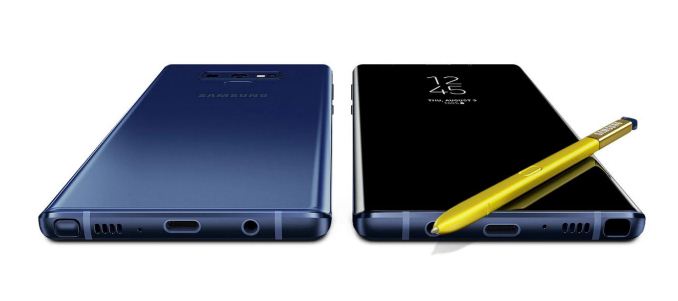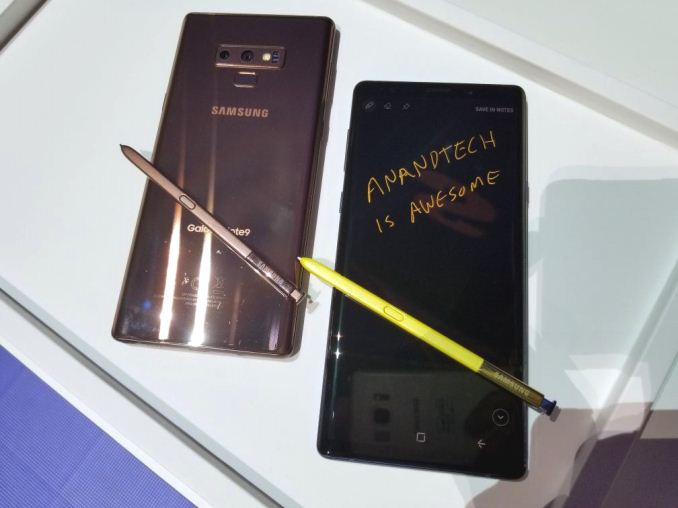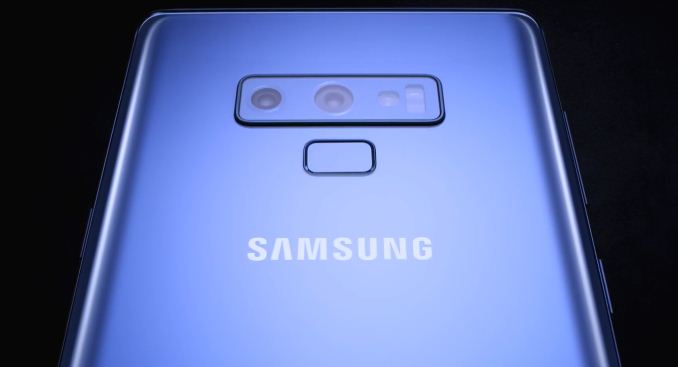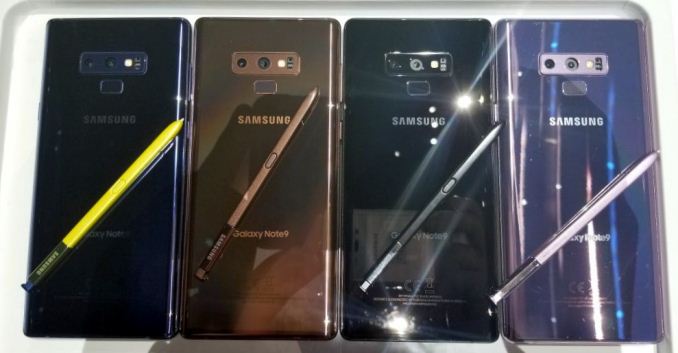Samsung Announces The Galaxy Note 9: 4000mAh And New S-Pen
by Andrei Frumusanu & Nate Oh on August 9, 2018 1:05 PM EST- Posted in
- Mobile
- Samsung
- Galaxy
- Smartphones
- Note 9

Today at the Unpacked Event at the Barclays Center in New York Samsung launched alongside a new smartwatch, the Galaxy Watch and a new home speaker, the Galaxy Home, the main subject of the show, the new Galaxy Note 9.
Samsung’s marketing focus for the Note 9 focused primarily on two new improved features: An increased battery capacity, and an increase in the storage capacity of the phones.
Let’s go over the specifications to see all of the new internals of the new summer flagship;
| Samsung Galaxy Family | |||
| Samsung Galaxy Note 8 | Samsung Galaxy Note 9 | ||
| SoC | (US, China, Japan) Qualcomm Snapdragon 835 4x Kryo 280 (CA73) @ 2.35GHz 4x Kryo 280 (CA53) @ 1.90GHz Adreno 540 @ 670MHz |
(Americas, China, Japan) Qualcomm Snapdragon 845 4x Kryo 385 (CA75) @ 2.8GHz 4x Kryo 385 (CA55) @ 1.77GHz Adreno 630 @ 710MHz |
|
| (Rest of World) Samsung Exynos 8895 4x Exynos M2 @ 2.30GHz 4x Cortex-A53 @ 1.70GHz ARM Mali-G71MP20 @ 546MHz |
(Rest of World) Samsung Exynos 9810 4x Exynos M3 @ 1.8-2.7GHz 4x Cortex-A53 @ 1.76GHz ARM Mali-G72MP18 @ 572MHz |
||
| Display | 6.3-inch 2960x1440 (18.5:9) SAMOLED (curved edges) |
6.4-inch 2960x1440 (18.5:9) SAMOLED (curved edges) |
|
| Dimensions | 162.5 x 74.8 x 8.6 mm 195g |
161.9 x 76.4 x 8.8 mm 201g |
|
| RAM | 6GB LPDDR4X | 6GB / 8GB LPDDR4X | |
| NAND | 64GB / 128GB (UFS) + microSD |
128GB / 512GB (UFS) + microSD |
|
| Battery | 3300mAh (12.7Wh) non-replaceable |
4000mAh (15.4Wh) non-replaceable |
|
| Front Camera | 8MP, f/1.7 | 8MP, f/1.7 | |
| Rear Cameras | 12MP, 1.4µm pixels, f/1.7, dual-pixel PDAF, OIS |
12MP, 1.4µm pixels, f/1.5 / f/2.4 adaptive aperture, dual-pixel PDAF, OIS |
|
| 2x zoom telephoto 12MP, f/2.4, OIS |
2x zoom telephoto 12MP, f/2.4, OIS |
||
| Modem | Snapdragon X16 LTE (Integrated) 2G / 3G / 4G LTE (Category 16/13) |
Snapdragon X20 LTE (Integrated) 2G / 3G / 4G LTE (Category 18/13) |
|
| Samsung LTE (Integrated) 2G / 3G / 4G LTE (Category 16/13) |
Samsung LTE (Integrated) 2G / 3G / 4G LTE (Category 18/13) |
||
| SIM Size | NanoSIM | ||
| Wireless | 802.11a/b/g/n/ac 2x2 MU-MIMO, BT 5.0 LE, NFC, GPS/Glonass/Galileo/BDS |
||
| Connectivity | USB Type-C, 3.5mm headset | ||
| Features | fingerprint sensor, heart-rate sensor, iris scanner, face unlock, fast charging (Qualcomm QC 2.0, Adaptive Fast Charging, USB PD), wireless charging (WPC & PMA), IP68, Mobile HDR Premium |
||
| Launch OS | Android 7.1.1 Samsung Experience | Android 8.1 Samsung Experience | |
In terms of SoC, the Note9 follows in the steps of the Galaxy S9 and employs the same Snapdragon 845 and Exynos 9810. We’ve extensively covered the two new chipsets in our review of the S9 earlier in the year. The Snapdragon 845 is a fantastic chipset for 2018 – while the Exynos 9810 showed some weakness in terms of performance as well as power efficiency – showcasing a particularly large gap this year.
It’s been some time that Samsung actually talked about the internals of its Galaxy devices, so it was particularly surprising to hear an emphasis on the performance of the chipsets this year round. Gaming was one topic where Samsung pulled in outside help to promote the Note 9 – Tim Sweeney was on stage unveiling the early Android beta launch of Fortnite for Samsung Galaxy phones, as well an exclusive in-game skin for Note 9 users.
Both the Snapdragon and Exynos S9 showcased thermal throttling in 3D games, and it seems Samsung took note of this and actually introduced a new beefier thermal dissipation solution in order to better cool the SoC and maintain higher performance.
The Note 9 comes in 6 GB or 8GB RAM variants, tied together with doubled base storage capacity of 128GB and with an enormous 512GB in the higher tiered variant.
In terms of display, we see the same resolution as on the Note 8 and S9 – employing a 18.5:9 2960x1440 AMOLED screen. The diagonal has increased this time around to 6.4”, and indeed this has increased the footprint of the device as the width has widened 1.6mm to 76.4mm.
A notable increase in comparison to the Note 8 is the Note 9’s battery capacity. Here we see a 21% increase to reach the 4000mAh mark. While this is certainly a psychologically large number, the 14% boost versus the Galaxy S9+ is still within reasonable levels of improvements, and I think Samsung’s taking a bit of a heavy-handed marketing approach here when it comes to the battery promises – especially for the Exynos variants in EMEA and SEA markets.
The camera of the Note 9 is the same as on the S9+ - this includes again the main 12MP sensor with 1.4µm pixel pitch with full dual-pixel PDAF layout, and a variable aperture of either f/1.5 or f/2.4. The telephoto lens also is the same with a 2x optical zoom capability. Both modules support OIS.
The one point where the Note 9 promises to improve camera capture in is through the introduction of neural network based inferencing and scene recognition. The Note 9 is said to recognize 20 scenarios and apply a respective image processing such as colour temperature adjustments. Again, this is something we’ve seen in the past introduced by various vendors, but if one thing we’ve come to discover over the last few months is that the implementation can be a hit & miss – so Samsung will have to focus on getting this right.
The fingerprint sensor sees the same design change as on the S9 and is now located centrally below the camera modules.
Finally the biggest feature improvement on the Note 9 is the new S-Pen: The new unit is no longer just a passive component, but now is an active remote working over Bluetooth LE and has its own little battery incorporated. The phone is said to be able to charge the S-Pen in 40 seconds for 30 minutes of usage – or when it’s actually discharged then it doesn’t limit the traditional functions which still work as passive components. In addition to the new remote functionality, the new S-Pen has a finer tip and increases the pressure sensitivity to 4096 levels.
The Note 9 is now available for preorder with availability on August 24th at prices of USD $999 for the 6GB/128GB base variant and $1249 for the 8GB/512GB version.














49 Comments
View All Comments
milkywayer - Saturday, August 11, 2018 - link
🤔N Zaljov - Friday, August 10, 2018 - link
SM-N960F (Note9 Exynos) BSP still relies on Linux 4.9.59, which is the same version used on the S9 Exynos.gregoryzeng - Sunday, December 16, 2018 - link
Bought my T-Mobile here in Australia from our local dealer, Kogan, (Melbourne, via eBay).Had an upgrade at least once now.
Running last update: 25 November, 2018. Android 8.1.0; Samsung Experience version 9.5; Kernel 4.9.65-14501686, ... , dated Wed Oct 31. 17:39:23 KST 2018.
Inbuilt "About Phone" has heaps of other details as well, but unsure what these mean.
saleri6251 - Thursday, August 9, 2018 - link
Hello Andrei,Just curious, I know you're a big fan of the Galaxy phones, but what are your thoughts usually on the note series in general from past experiences, like the note 8?
Andrei Frumusanu - Thursday, August 9, 2018 - link
I've personally never used the S-Pen much and found them too big - so I think the S+ make make more sense.s.yu - Friday, August 10, 2018 - link
For using LR mobile or any other app involving anything close to drawing (masking in LR's case) or precise control S-Pen is a must.Tams80 - Friday, August 10, 2018 - link
Which is fine all, but a rather silly reason to dislike it when there has now been essentially a version without the S-Pen for several years.Honestly, someone who has no or little use for a stylus shouldn't be reviewing a Note device (or other stylus orientated devices). It sends out a message to companies that styluses aren't wanted, when there is a significant niche who really do want them.
Calabros - Thursday, August 9, 2018 - link
$1250!maroon1 - Tuesday, August 14, 2018 - link
Than for 512GB /8Gb ram versionThe 128GB /6GB ram version is $999
gregoryzeng - Sunday, December 16, 2018 - link
Add on another micro-SD card of 400 or more gigabytes. Then swap these add-on memories, for even more storage.Better still, real-time or otherwise, the memory contents to the cloud (Amazon, Google, etc).